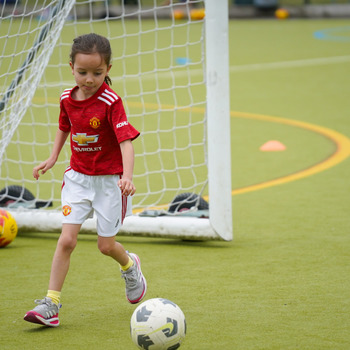THE ATHLETIC BIBAO COACH MARCELO BIELSA IS LARGELY RESPONSIBLE FOR A STYLE OF PLAY LEADING TO MORE GOALS AROUND THE WORLD
A spectre is haunting Europe – the spectre of goals. They're everywhere – in every competition, in every country, in every stadium (apart from games involving Sunderland). Four-goal leads are regularly obliterated (Angola v Mali, Newcastle v Arsenal, Germany v Sweden, Arsenal v Reading). Lionel Messi, Cristiano Ronaldo and Radamel Falcao break goalscoring records every week. Everybody attacks, all the time.
In the top flights of England, France and Spain, there has been a clear upward trend in the number of goals scored per game over the past decade. Last season, for the first time, the knockout stage of the Champions League yielded more than three goals per game and that has continued into this season's group stage, with 3.03 goals per game. And even in Italy and Germany, where goals per game have remained relatively constant for 10 years, this season is showing above-average numbers of goals.
Over the last 10 seasons, the average number of goals scored per Premier League game has shown a steady rise. Starting in 2003-04, the figure for average goals per game for each season reads 2.66, 2.56, 2.48, 2.45, 2.63, 2.47, 2.77, 2.79, 2.80. This season, with all but Sunderland and Reading having played 11 games, the average stands at 2.82. If that were to be sustained to the end of the season, it would be the highest average since 1967-68. And yet it is still lower than the remarkable 2.94 in La Liga this season.
There has been a clear increase in the Premier League from 2009-10 onwards. In part that appears to be down to a better shot conversion rate which, having hovered between 11.8 and 12.8% for the previous six seasons has been at over 13% (this season stands at a 10-season high of 13.54%) for four seasons. That could be down to strikers becoming more efficient or it could be down to a better type of chance being created.
Perhaps more significant is the fact that average passes per game have also seen a clear increase, climbing from 717 in 2006-07 to 862 so far this season. That has coincided with an improvement in passing accuracy: from 70-75% a decade ago (a low of 70.51% in 2006-07, the season that also brought the lowest average goals per game in the past decade of 2.45) to 76.24% in 2010-11, 79.65% last year and 81.69% this season.
That correlation seems relatively easy to explain: more passes and better pass completion would suggest easier, probably shorter, passes are being attempted; more teams, in other words, are attempting to play possession-based football. That theory seems to be confirmed by the fact that the percentage of passes played into the final third has shown a steady decrease in recent seasons, from a high of 38.8% in 2007-08 to just 32% last season and 30.9% so far this, and that the number of crosses per game has dropped, from over 40 a decade ago to 34.52 last season and 35.81 so far this.
And because teams are focusing more on passing the ball, they are focusing less on winning it back. Tackle statistics only exist from 2006-7, when there were 47.5 per game. That figure has fallen every season to a low of 37.67 last year. So far this year, the average is 38.74. Fouls, similarly, have come down, from 28 per game a decade ago to 21.86 last season. It's probably telling that in that period, yellow cards have remained relatively steady at around three per game if anything showing a slight rise.
This is a trend repeated across Europe. More passing, less tackling.
In part, the lawmakers must take credit (or blame). The changes in the offside law have increased the effective playing area, permitting the return of the sort of diminutive, skilful midfielder who had been all but eradicated from central areas of the pitch a decade ago. Tackling is increasingly restricted: the snapping, snarling ball-winner has been all but refined from the game and that means more technically gifted players can't be intimidated.
But there has also been a fundamental change of attitude that was perhaps best encapsulated by Sir Alex Ferguson in an interview he gave in May when asked if his target over the summer would be a holding midfielder. "If you look at the examples, [Cesc] Fábregas was one of the best midfield players in England for five years but he wasn't a big lad and wasn't a holding player," he said. "He was an attacking player. Xavi [Hernández] and [Andrés] Iniesta are small players – you can't call them holding players. I don't think we've had a holding player since I've been here. We've never had a holding player. We tried to get Roy Keane to do that but he just couldn't do it. He had to play a way that was his way of playing, so I've not had it for 25 years. Why should I think about it now?"
The answer was slightly disingenuous: United may not have had a holding player in the sense of a Claude Makelele-type who would sit in front of the back four, but in the likes of Keane, Paul Ince, Nicky Butt and Bryan Robson, they have certainly had ball-winners. It may be that Darren Fletcher if he fully recovers from his colitis, can return to that role, but Ferguson doesn't see it as a priority.
What's even more striking, though, is the behaviour of the two English teams who were the major prize-winners last season. Chelsea, having ground their way to the Champions League, now play with a dazzling trio of attacking midfielders who have a habit of leaving their full-backs exposed. Doggedness and defiance can bring one trophy, the message seems to be, but something far more proactive is necessary if pre-eminence is to be sustained. The sale of Nigel de Jong, the sidelining of Joleon Lescott for Matija Nastasic and the dabbles with a back three, meanwhile, all seem to suggest that Manchester City are attempting to play a more possession-based game.
Football, in the past couple of years, has gone through a process of Bielsafication. At the highest level, virtually everybody now tries to win the ball back high up the pitch, trying to score with quick transitions. That means that the ability for a central defender not to give the ball away, not to panic when two or three forwards close him down, becomes paramount – and that in turn means that ability on the ball comes to be prized almost as much as the ability to win a tackle or a header. At the same time, thanks to Spain, it's now accepted that the safest way not to concede goals is not to concede possession.
That's why Marcelo Bielsa, the high priest of this style of football, has so often used a central midfielder as a defender. He did it was Gary Medel with Chile and Javi Martínez with Athletic Bilbao and it's not hard to see the influence of his thinking in Pep Guardiola's decision to convert Javier Mascherano – and at times Sergio Busquets – into centre-backs.
Bielsa developed his theories at Newell's Old Boys in Rosario in the early 90s, yet the odd thing is that he won virtually nothing with them. His two titles with Newell's both came before the 6-0 Copa Libertadores defeat to San Lorenzo in 1992 that persuaded him to submit to the radicalism in his soul. It wasn't just that he played a 4-3-3/3-4-3 hybrid (like Louis van Gaal at Ajax and Johan Cruyff at Barcelona at the same time, he favoured a shape that was essentially a flattened diamond sandwiched by an attacking line of three and a defensive line of three); it was the ferocity of the pressing and the relentlessness of his attacking that marked him out.
Newell's reached the final of the Libertadores but lost to São Paulo and Bielsa left for Atlas in Mexico. Narrow failure, exhausted troops failing at the last, were to become a familiar pattern. He won another title at Vélez Sarsfield and Olympic gold with Argentina but that aside his career has been characterised by near misses. Last season, Athletic, having played some stunning football in the spring, was defeated in the finals of both the Europa League and the Copa del Rey.
The feeling is that Bielsa may be too much of a fundamentalist: as he has said, if football were played by robots, he would win everything. Human limitations he seems to find harder to deal with.
Yet his followers, those who temper his ideals with realism, are coming to dominate. Jorge Sampaoli has led Universidad de Chile to three straight titles and last year's Copa Sudamericana. Guardiola, who shared a 12-hour with Bielsa before taking the Barcelona job, won three Spanish titles and a Champions League. Gerardo Martino took Paraguay to the Copa America final and has led Newell's title charge this season. Even when there is no direct link, few of Europe's bright young managers are not Bielsista in outlook: most notably André Villas-Boas (even if he has reined in the high line this season) and Jürgen Klopp.
Only international football remains aloof, the lack of time available for coaches to drill their players in the organised pressing required for Bielsista football leading to a more cautious, deeper-lying approach.
As Celtic showed against Barcelona, it's not the only way to play, but it is the modish way to play and, for the moment, the combination of laws that encourage technical football and a prevailing high-tempo, attacking philosophy is producing goal-packed, thrilling football. The counter-revolution will come but for now, at the highest club level, it's all about Bielsisme.



